Separation of biologically relevant isomers on an Orbitrap mass spectrometer using high-resolution drift tube ion mobility and varied drift gas mixtures
2022
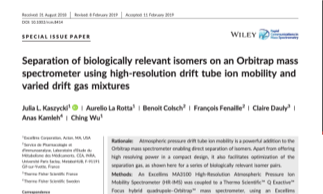
Atmospheric pressure drift tube ion mobility is a powerful addition to the Orbitrap mass spectrometer enabling direct separation of isomers by their size and shape.
Read More

Separations of Carbohydrates with Noncovalent Shift Reagents by Frequency-Modulated Ion Mobility-Orbitrap Mass Spectrometry
2021
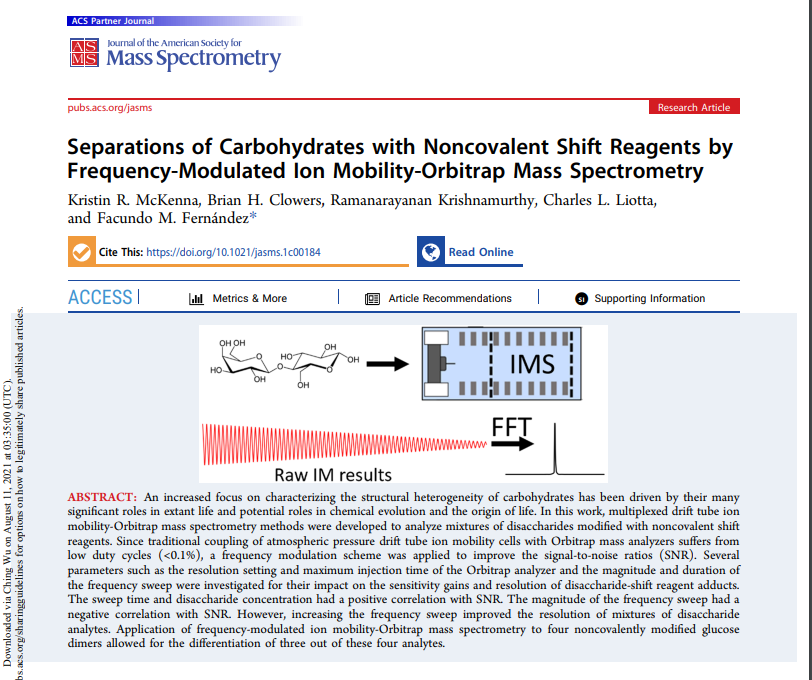
In this work, multiplexed drift tube ion mobility-Orbitrap mass spectrometry methods were developed to analyze mixtures of disaccharides modified with noncovalent shift reagents
Read More
Combined secondary electrospray and corona discharge ionization (SECDI) for improved detection of explosive vapors using drift tube ion mobility spectrometry
2019
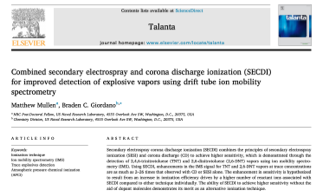
This paper demonstrates how secondary electrospray corona discharge ionization (SECDI) combines the principles of secondary electrospray ionization (SESI) and corona discharge (CD) to achieve higher sensitivity.
Read More
Separation of biologically relevant isomers on an Orbitrap mass spectrometer using high‐resolution drift tube ion mobility and varied drift gas mixtures
2019

HPIMS is a powerful addition to the Orbitrap mass spectrometer, enabling direct separation of isomers. This paper shows compounds demonstrated significantly better analytical separation when analyzed in a mixture of CO2 and air rather than air or CO2 alone.
Read More
Atmospheric Pressure Drift Tube Ion Mobility − Orbitrap Mass Spectrometry: Initial Performance Characterization
2017

This paper showcases the optimized AP-DTIMS-Orbitrap MS system; isobaric peptide and sugar isomers were successfully resolved and the identities of separated species validated by high-energy collision dissociation experiments.
Read More
Ion Mobility Spectrometry - High Resolution LTQ-Orbitrap Mass Spectrometry for Analysis of Homemade Explosives
2017

In this paper, HPIMS coupled with MS (ion mobility mass spectrometry: IMMS) is shown to allow better signature assignments of threat compounds, modified detection algorithms, and improved overall explosive trace detection performance.
Read More
Determination of Artificial Sweeteners by High Performance Ion-Mobility Spectrometry with Electrospray Ionization
2016
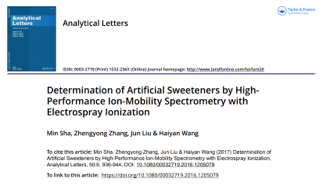
In this paper, Acesulfame-K, sodium saccharin, sodium cyclamate, aspartame, and neotame were determined by high-performance ion-mobility spectrometry with direct electrospray ionization (ESI-HPIMS).
Read More
Augmenting Ion Trap Mass Spectrometers Using a Frequency Modulated Drift Tube Ion Mobility Spectrometer
2016

Historically, high pressure ion mobility drift tubes have suffered from low ion duty cycles and this problem is magnified when coupled with ion trap mass spectrometers. HPIMS coupled with MS (ion mobility mass spectrometry: HPIMS-IMS) is shown to lower analyte detection limits, and improve spectral quality.
Read More
Analysis of Ammonium Nitrate/Urea Nitrate with Crown Ethers and Sugars as Modifiers by Electrospray Ionization-Mass Spectrometry and Ion Mobility Spectrometry
2016

Ammonium nitrate (AN) and urea nitrate (UN) are commonly used materials in improvised explosive devices (IEDs). Detection by mass spectrometry (MS) and/or ion mobility spectrometry (IMS) is traditionally difficult. Here, HPIMS with Electrospray Ionization is proven a valuable explosive trace detection technology
Read More
Analysis of synthetic cathinones and associated psychoactive substances by ion mobility spectrometry
2014

The detection and characterization of cathinone drugs is complicated by the ever-growing size of the family. There are very few methods reported for improving presumptive screening of seized materials. These results show that HPIMS is an acceptable rapid and efficient screening tool for cathinones, positively detecting at least one cathinone in 77% of the drugs of abuse samples tested
Read More
Analysis of explosives using corona discharge ionization combined with ion mobility spectrometry–mass spectrometry
2014

The most common ionization source for the analysis of explosives by IMS is radioactive 63Ni, used to ionize explosive vapors. However, the health risks of 63Ni, as well as low ion signals, have led many researchers to investigate other ionization techniques for analyzing explosives. This paper presents an alternative analysis of explosives using corona discharge ionization combined with high performance ion mobility spectrometry–mass spectrometry.
Read More
Improved detection of drugs of abuse using high-performance ion mobility spectrometry with electrospray ionization (ESI-HPIMS) for urine matrices
2013

HPIMS with electrospray ionization is used to separate drugs of abuse compounds. This paper shows the technique provides a simple “dilute-and-shoot” method to be used to detect a mixture of codeine and morphine in urine matrix.
Read More
High-performance ion mobility spectrometry with direct electrospray ionization (ESI-HPIMS) for the detection of additives and contaminants in food
2013

In this paper, HPIMS with an electrospray ionization (ESI) source detects chemical contamination of food and additive compounds identified as critical to monitoring the safety of food samples.
Read More
Structure selective ion molecule interactions (SSIMI) in ion mobility spectrometry
2013

Ion mobility spectrometry (IMS) is commonly used for the detection of chemical warfare agents, toxic industrial chemicals and drugs of abuse testing, but has a reputation of false positive responses. This paper demonstrates the use of HPIMS to lower false positive alerts.
Read More
Separation mechanism of chiral impurities, ephedrine and psuedoephedrine, found in amphetamine-type substances using achiral modifiers in the gas phase
2012

Separation of enantiomers are notoriously difficult & expensive using legacy techniques like GC, due to the trial & error nature of analyses. This paper reports the use of HPIMS for the effective separation of chiral molecules using achiral modifiers.
Read More
Secondary Electrospray Ionization-Ion Mobility Spectrometry for Explosive Vapor Detection
2010

Secondary electrospray ionization in HPIMS allows rapid analysis of explosive samples that are difficult to detect using conventional IMS systems while providing resolving powers, R, greater than 60 and good sensitivity toward the troublesome homemade explosives (HME). The paper demonstrates the technique as a powerful explosive trace detection technology.
Read More
High resolution electrospray ionization ion mobility spectrometry
2009

This paper describes how electrospray ionization in HPIMS allows direct analysis of non-volatile organic and biological samples, and avoids decomposition of thermally labile samples, providing reliable chemical identification.
Read More
Gas-Phase Chiral Separations by Ion Mobility Spectrometry
2006
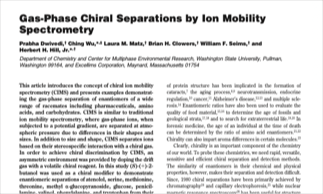
This article by Washington State University introduces the concept of chiral ion mobility spectrometry (CIMS) and presents examples demonstrating the gas-phase separation of enantiomers of a wide range of racemates including pharmaceuticals, amino acids, and carbohydrates.
Read More